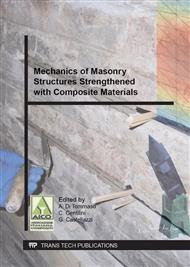p.11
p.19
p.27
p.43
p.51
p.59
p.66
p.74
p.80
Strengthening of Thin Masonry Arches
Abstract:
The innovative technique here illustrated is the result of historical evolution of an ancient system of reinforcing tiled vaults belonging to the constructive Spanish tradition. Such a traditional technique consists in the lamination of flat rectangular tiles or thin bricks into thin vaults known as boveda tabicada. Since the use of modern technologies may improve the mechanical performance of the traditional materials, the core of the proposed strengthening system is based on the idea of combining the peculiar features of tabicada technique with the good tensile properties of composite materials. More in detail, it is possible to obtain reinforced masonry vaults or arches by overlapping different layers of tiles or thin bricks and laminates, embedded within an hydraulic mortar, so that the entire assembly may act as a single structural unit. Eighteen prototypes of tiled arches were tested under a monotonic vertical load applied at the keystone. The influence of the types of reinforcement, number of layers and properties of hydraulic mortar has been investigated. Laboratory outcomes are presented and discussed in the paper considering mechanical behavior of specimens and axial stress-axial strain relationships.
Info:
Periodical:
Pages:
51-58
Citation:
Online since:
September 2014
Authors:
Keywords:
Price:
Сopyright:
© 2015 Trans Tech Publications Ltd. All Rights Reserved
Share:
Citation:


